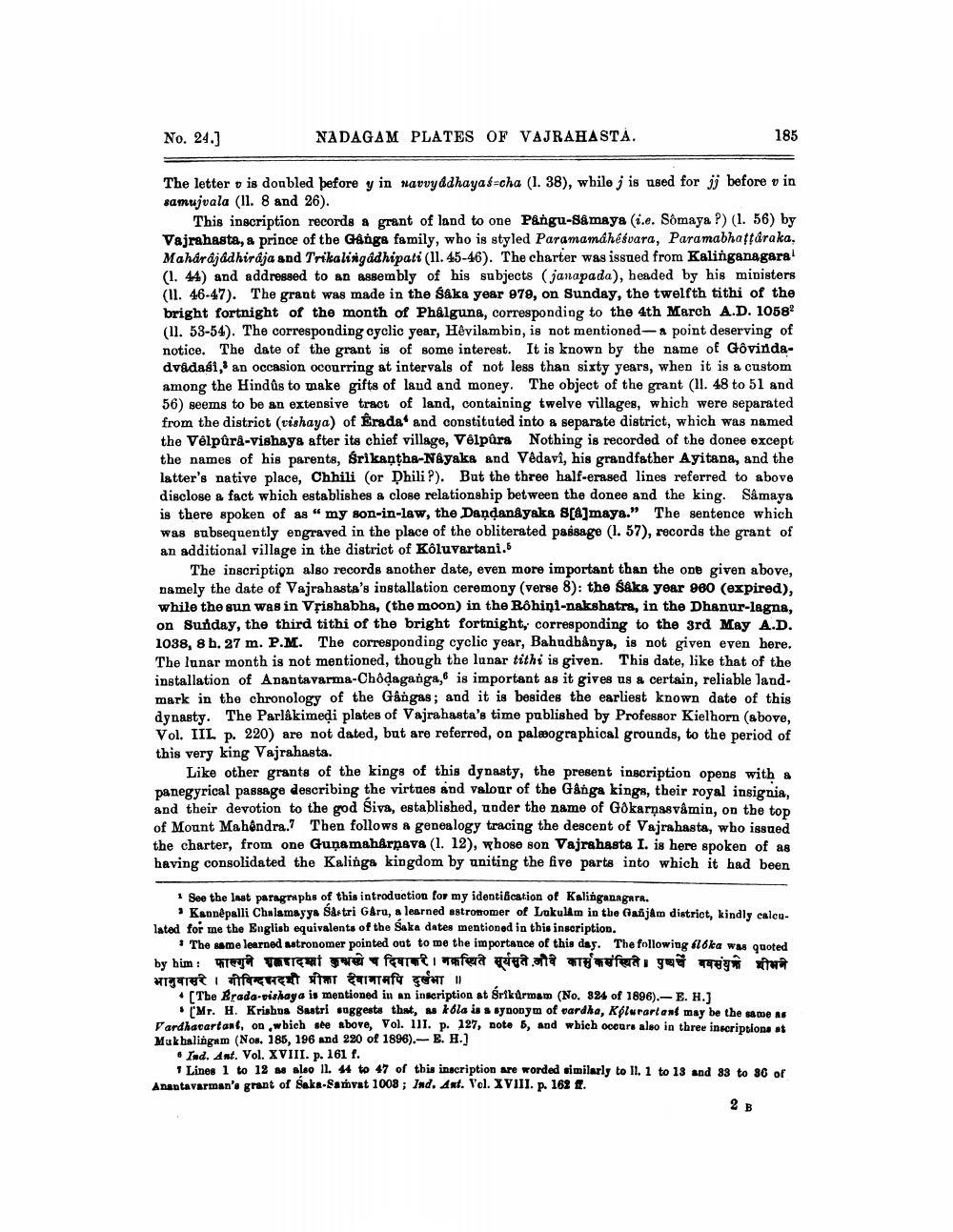________________
No. 24.]
NADAGAM PLATES OF VAJRAHASTA.
185
The letter v is doubled before y in navvyddhayas-cha (1. 38), while j is used for jj before v in samujvala (11. 8 and 26).
This inscription records a grant of land to one Pangu-Samaya (ie. Somaya ?) (1. 56) by Vajrahasta, a prince of the Ganga family, who is styled Paramamahétvara, Paramabhattáraka, Maharajadhiraja and Trikalingadhipati (11. 45-46). The charter was issued from Kalinganagara! (1. 44) and addressed to an assembly of his subjects (janapada), headed by his ministers (II. 46-47). The grant was made in the saka year 979, on Sunday, the twelfth tithi of the bright fortnight of the month of Phâlguna, corresponding to the 4th March A.D. 1058 (11. 53-54). The corresponding cyclic year, Hevilambin, is not mentioned - a point deserving of notice. The date of the grant is of some interest. It is known by the name of Govindadvadasi, an occasion occurring at intervals of not less than sixty years, when it is a custom among the Hindus to make gifts of land and money. The object of the grant (11. 48 to 51 and 56) seems to be an extensive tract of land, containing twelve villages, which were separated from the district (vishaya) of Erada' and constituted into a separate district, which was named the Vélpüra-vishays after its chief village, Vélpürs Nothing is recorded of the donee except the names of his parents, Srikantha-N&yaka and Vedavi, his grandfather Ayitana, and the latter's native place, Chhili (or Dhili?). But the three half-erased lines referred to above disclose a fact which establishes a close relationship between the donee and the king. Såmaya is there spoken of as “my son-in-law, the Dandanayaka S[A]maya." The sentence which was subsequently engraved in the place of the obliterated passage (1. 57), records the grant of an additional village in the district of Kôluvartani.
The inscription also records another date, even more important than the one given above, namely the date of Vajrahasta's installation ceremony (verse 8): the Såka year 960 (expired), while the sun was in Vțishabha, (the moon) in the Rôhiņi-nakshatra, in the Dhanur-lagna, on Sunday, the third tithi of the bright fortnight, corresponding to the 3rd May A.D. 1038, 8 h. 27 m. P.M. The corresponding cyclic year, Bahudbånya, is not given even here. The lunar month is not mentioned, though the lunar tithi is given. This date, like that of the installation of Anantavarma-Chôdaganga, is important as it gives us a certain, reliable land. mark in the chronology of the Gångas; and it is besides the earliest known date of this dynasty. The Parlâkimeņi plates of Vajrahasta's time published by Professor Kielhorn (above, Vol. IIL p. 220) are not dated, but are referred, on palæographical grounds, to the period of this very king Vajrahasta.
Like other grants of the kings of this dynasty, the present inscription opens with a panegyrical passage describing the virtues and valoar of the Ganga kings, their royal insignia, and their devotion to the god Siva, established, under the name of Gokarnasvamin, on the top of Mount
[email protected] Then follows a genealogy tracing the descent of Vajrahasta, who issued the charter, from one Guņamahårpava (1. 12), whose son Vajrahasta I. is here spoken of as having consolidated the Kalinga kingdom by uniting the five parts into which it had been
See the last paragraphs of this introduction for my identification of Kalinganegara.
• Kannepalli Chalamayya Sastri Garu, a learned astronomer of Lukulam in the adjam distriot, kindly calcu. lated for me the English equivalents of the Saka dates mentioned in this inscription.
The same learned astronomer pointed out to me the importance of this day. The following €16ka was quoted br him: फाल्गुने पादा कुनथेच दिवाकरी । नक्रस्थिते सूर्यसुते नौवे कार्सकसरिखते। पुष्य, बषसंयक भीमने भानुवासरे। गीविन्दमदशी प्रीता देवानामपि दुर्खभा ॥
*The Brada-pishaya is mentioned in an inscription at Srikarmam (No. 824 of 1896).-E. H.]
Mr. H. Krishna Sastri suggests that, as kola is a synonym of vardha, kplurarlant may be the same as Vardhacartan, on wbich see above, Vol. 111. p. 127, note 5, and which occurs also in three inscriptions at Mukhalingam (Nos. 185, 196 and 220 of 1896).- E. H.)
. Ind. Ant. Vol. XVIII. p. 161 f.
+ Lines 1 to 12 m aloo II. 44 to 47 of this inscription are worded similarly to 11. 1 to 13 and 83 to 36 of Anantavarman'a grant of Saka-Banyat 1008; Ind. Ant. Vol. XVIII. p. 162 I.
